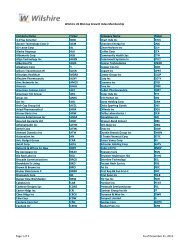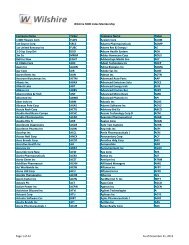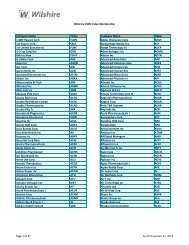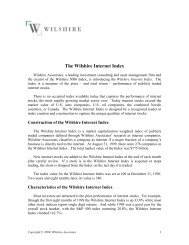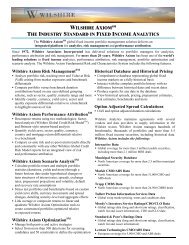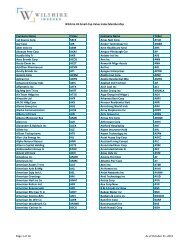Fundamentally Active - Wilshire Associates
Fundamentally Active - Wilshire Associates
Fundamentally Active - Wilshire Associates
Create successful ePaper yourself
Turn your PDF publications into a flip-book with our unique Google optimized e-Paper software.
Fundamental indexes are a core investment<br />
Dividend weighting schemes that eliminate approximately 60% of the non-dividend paying universe<br />
cannot be considered core investments but many fundamental methods invest in all sizes and styles of<br />
stocks. It is clear that most fundamental indexes have a strong value and/or small-cap tilt compared to a<br />
cap-weighted index. In fact, the factors chosen for RAFI and WisdomTree inclusion as well as portfolio<br />
weights are traditional value metrics. Steven Schoenfeld summed up this style tilt well: “RAFI’s<br />
composite-weighted index is, in fact, a naïve approach to a multi-factor model with well-documented<br />
value factors (and therefore exposures) that have performed very well since the 1960s.” 18<br />
Fundamental investing is a no-skill method for outperformance<br />
Eugene Fama and Ken French documented the persistent return attribute to value and small-cap going<br />
back to the 1960s. 19 The question is: Does fundamental investing deliver outperformance versus an<br />
investment strategy with the specific goal of capturing a value and size premium? William Bernstein’s<br />
answer was that “slightly less than two-thirds of the ‘excess return’ of the RAFI over the S&P [500] is<br />
due to naïve factor exposure, and slightly more than one-third seems to be inherent to the technique.<br />
Unfortunately, this latter effect is not statistically significant, raising the issue of data mining.” 20<br />
RAFI’s outperformance in other markets proves that cap-weighting is flawed<br />
Alternatively weighted supporters claim that since fundamental indexes outperform cap-weighted indexes<br />
in every market and every size category, then the cap-weighted methodology must be flawed. The<br />
reported outperformance is the value premium, which has been documented as a global phenomenon by<br />
Fama and French in 1998 21 and updated by the Brandes Institute in 2006. 22<br />
Fundamental indexes offer higher returns at similar or lower risk levels<br />
As the adage goes: If an investment offers higher returns with similar to lower risk, then invest in it. Most<br />
risk measures begin or end with the standard deviation of returns. Table 4 shows that the standard<br />
deviation of the RAFI compared to the Dow Jones <strong>Wilshire</strong> Large-Cap Index SM implies that the RAFI has<br />
lower risk. When comparing the RAFI to a more representative value benchmark such as the DJ <strong>Wilshire</strong><br />
Large-Cap Value Index SM or DJ <strong>Wilshire</strong> 2500 Value Index SM , the “similar or lower risk” statement no<br />
longer holds.<br />
18 Steven A. Schoenfeld.<br />
19 Fama, Eugene and Ken French, “The Cross-Section of Expected Stock Returns,” Journal of Finance (June 1992).<br />
20 William J. Bernstein, “Fundamental Indexing and the Three-Factor Model,” EfficientFrontier.com (May 2006).<br />
21 Fama, Eugene F. and Kenneth R. French, “Value versus Growth: The International Evidence,” Journal of<br />
Finance 53 (December 1998): page 1976-1999.<br />
22 “Value vs. Glamour: The Value Premium in Non-U.S. Markets,” www.brandes.com/institue, December 2006.<br />
<strong>Fundamentally</strong> <strong>Active</strong><br />
Copyright © 2007, <strong>Wilshire</strong> <strong>Associates</strong> Incorporated. All rights reserved.<br />
Page 6



